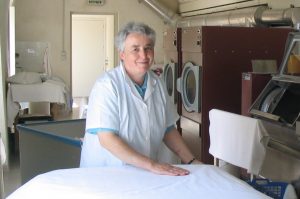Just like the priests and the consecrated laymen, the laywomen of Notre Dame de Vie want to unite contemplation and action in their professional, social and church life, according to the charism common to the three branches.
An original vocation in the Church
They are four main characteristic features of the vocation of the consecrated laywomen of Notre Dame de Vie :
- Members are fully consecrated to God by the profession of the evangelical counsels (chastity, poverty and obedience)
- They are fully laypeople as exercising a profession in the midst of the world and sharing the ordinary lives of their contemporaries.
- Their spiritual life is rooted in the spirit of Carmel and a life of prayer.
- They care about evangelization and commit themselves to serve the church through catechism, prayer groups, youth movements….
An appropriate preparation
The first period of formation lasts two years and takes place in Venasque, France or in Encanto, the Philippines.
It mainly consists of gaining a practical competence in silent prayer, deepening knowledge of Scripture and receiving the spirituality of the Carmelite saints as a staple diet. Through the simple realities of everyday, members get used to living in the presence of God, listening to the Holy Spirit and putting themselves at His disposal. The timetable of everyday contributes to this training in a concrete way.
« You are here so that you can forge for yourselves souls of which God may become the strength, the lights and the life…Our aim is to make you become aware of the absolute of God so that you can receive it into your life and already become used to giving Him everything. »
Father Marie-Eugène (04/11/1966)
At the end of these two years, members commit themselves in a total gift of self to the Institute of Notre Dame de Vie by vows of chastity, poverty and obedience.
The life is experienced for six years before definitive vows are ventured upon.
A life in the midst of the world
A professional insertion
Most of the members of Notre Dame de Vie have a professional activity in the various private or public sectors: business, medico-social, education, public service, medical…
Members live alone or in small groups, without visible signs of their consecration.
When they share a house, their way of life is more like a family than a community, each of them being responsible for finding her own rhythm so as to realize the demands of her vocation. For example, a senior manager will have a different rhythm from a schoolteacher.
The heart of this particular call to consecrated life for God, for people, is revealed gradually through the witness of life and through simple opportunities.
Praying everyday
Each member put the Eucharist at the centre of her day and devotes two hours a day to prayer (silent prayer). Members pray Morning Prayer (Lauds) and Compline, thus participating in the Church’s Liturgy of the Hours.
And supported by a fraternal life

To ensure that their life is balanced and their apostolate fruitful, they regularly come back to a house where they revitalize themselves and which is like their family home. These returns are made each year for at least 3 consecutive weeks, often lived in a community; approximately every 12 years, the members leave their professional activities or other duties for one sabbatical year, entirely devoted to the search for God in prayer, solitude and support of fraternal life.
Members of the women’s branch are about 500 spread over 4 continents.




